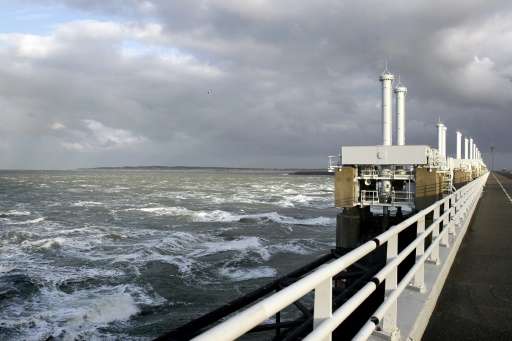Dutch project tests floating cities to seek more space

Dutch researchers unveiled Tuesday a model of what could become within two decades a floating mega-island to be used as a creative solution for accommodating housing, ports, farms or parks.
Made up of 87 floating triangles of different sizes, the huge, flexible island made of concrete or steel would eventually stretch 1.5 to two kilometres (one to 1.2 miles), or a total of three square kilometres.
Squeezed for space in this tiny northern European country, "some cities are starting to look into floating solutions, like a floating park on the river for example, where they want to have an area for recreation close by the city centre," Olaf Waals from the Maritime Research Institute of the Netherlands (MARIN) told AFP.
If plans for floating islands go ahead it would be a twist in the history of this low-lying country, much of which down the centuries has been reclaimed from the sea and which is protected from the waters by an intricate system of dykes and canals.
"In these times of rising sea levels, overpopulated cities and a rising number of activities on the seas, building up the dykes and pumping out the sands is perhaps not the most efficient solution," said Waals, referring to common methods to reclaim land.
"Floating ports and cities are an innovative solution which reflect the Dutch maritime tradition."
The model, which measures roughly six by eight metres and is made of wood and polystyrene, was laid out Tuesday in a huge water tank to simulate wind, waves and storms, in a presentation for several potential investors.
According to MARIN director Bas Buchner, discussions are underway with the local authority of crowded Haarlemmermeer and the Lelystad airport, both close to the burgeoning capital of Amsterdam, the daily Telegraaf reported.
But the project remains at the early stages, the institute said.
The islands would be anchored to the sea bed and also moored to the shore. But tests still need to be carried out on how they will withstand weather conditions and tidal movements and how to make them self-sufficient in energy and resources, as well as on the effects on marine life—and the cost.
The "Space at Sea" project in collaboration with other countries has won about 1.6 million euros ($1.8 million) in European subsidies to carry out three years of studies into different uses for such islands—from seaweed and fish farms to floating cities and ports.
"Technically it could be feasible in 10 to 20 years from today," Waals said.
According to MARIN such solutions are part of a "blue future" seeking sustainable and durable ways to use the oceans and seas which cover 70 percent of the Earth's surface.
Under growing pressure for space "the Netherlands will have to divert back towards the water," Buchner told the Telegraaf. "And we have always been pioneers in this fight."
© 2017 AFP





















